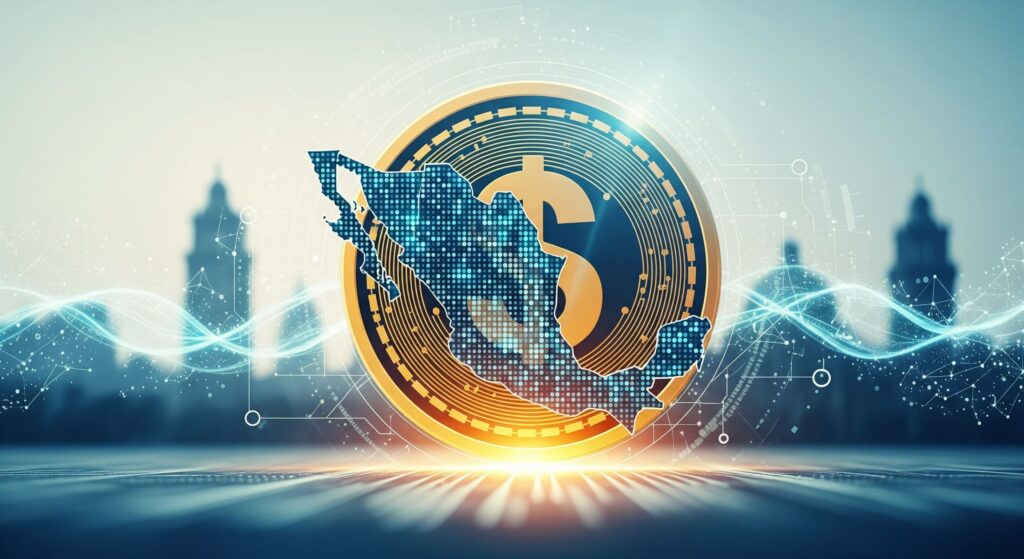Stablecoins Are Gaining Momentum in Mexico
In the first half of 2025, stablecoins represented 36% of all cryptocurrency purchases in Mexico. USDC led with about a quarter of transactions, followed by bitcoin, XRP, USDT, and ether. Although below the Latin American average of 46%, this marks a sharp increase in Mexico’s adoption of stable digital assets. Families, businesses, and investors are turning to these instruments as both a store of value and a practical medium of exchange.
Market Drivers for Stablecoin Adoption
- Inflation Hedge – Stablecoins provide a dollar-linked refuge for households seeking to protect their savings.
- Cross-Border Remittances – With remittances under pressure, stablecoins provide a fast, low-cost alternative for transferring value across borders.
- Payments & Commerce – Merchants and online platforms increasingly accept digital assets, broadening their practical use.
- Financial Inclusion – Stablecoins allow unbanked or underbanked populations to access a form of dollar exposure without opening traditional bank accounts.
Why Mexico Needs Regulated Non-Bank Structures for Crypto
To provide crypto services in Mexico, firms must operate under licensed entities. A SOFOM, especially a regulated SOFOM ER, creates a compliant framework to manage custody, trading, and investment products tied to digital assets. While an unregulated SOFOM ENR can serve as a starting point, regulated structures are necessary to build trust, scale operations, and access institutional partnerships.
Key benefits of a licensed entity include regulatory compliance, consumer protection through transparency and disclosure, and market credibility when offering custody or digital investment products.
Choosing the Right Structure for Digital Asset Services
| Structure Type | Ideal Use Case |
| SOFOM ENR | Entry-level entity for testing crypto services, basic advisory, or wallet solutions without public deposit-taking. |
| SOFOM ER | Regulated platform for lending, custody, and digital asset investment services. Best for scaling fintech or crypto firms. |
| SOFIPO / Digital Bank | Required when client funds are taken as deposits, enabling stablecoin savings accounts, remittance flows, and larger-scale financial inclusion models. |
Risks and Challenges in Offering Digital Assets
- AML and KYC Compliance – Crypto transactions are subject to strict anti-money laundering requirements.
- Market Volatility – Even stablecoins carry operational and counterparty risks.
- Regulatory Shifts – Laws governing fintech and digital assets evolve quickly; entities must adapt continuously.
- Consumer Education – Many retail users lack awareness of risks tied to digital currencies.
Cross-Border Synergy: Combining Mexico with Puerto Rico
One of the strongest models involves linking a Mexican SOFOM with an international bank in Puerto Rico:
- The Puerto Rican bank holds dollar custody, integrates with U.S. financial markets, and offers regulatory security.
- The Mexican SOFOM serves as the local face, onboarding customers, managing peso-denominated flows, and providing user access.
This dual structure allows Mexican and Latin American clients to benefit from both U.S. regulatory protection and Mexico’s dynamic digital asset market.
Regional Expansion Across Latin America
The same model used in Mexico can be replicated throughout Latin America. Options include:
- Sales Offices for customer acquisition.
- Commissioned Representative Offices to market services legally in neighboring countries.
- Local Licensed Entities for markets with high crypto adoption such as Brazil, Colombia, or Argentina.
By rolling out across the region, a company can build a pan-Latin American digital asset platform that connects users to global capital markets.
Conclusion: Building the Future of Digital Finance
Stablecoins and digital assets are rapidly reshaping the financial landscape in Mexico. With nearly four out of every ten crypto transactions already involving stablecoins, the demand is undeniable. To capture this momentum, providers must operate within the right legal frameworks—beginning with SOFOMs and, as operations scale, moving into more regulated structures.
By combining Mexico’s non-bank financial entities with U.S.-regulated international banks in Puerto Rico, global investors and local clients alike can access the best of both worlds: high-growth opportunities in Latin America and the stability of the U.S. financial system.
Contact us today to learn how we can help you establish a compliant, scalable non-bank financial institution in Mexico designed to offer crypto and digital asset investment services.

